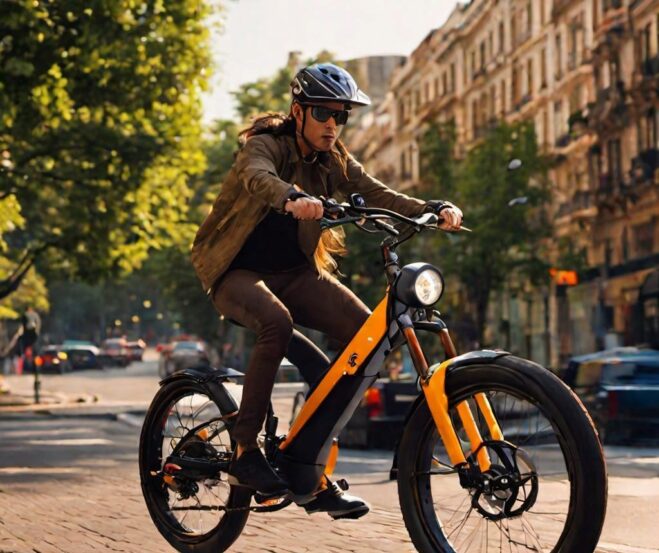Safety Precautions for E-bike Riders: Tips for a Safe Journey
As electric bikes continue to surge in popularity, ensuring rider safety has never been more paramount. The hybrid nature of e-bikes, combining traditional cycling with electronic assistance, creates unique challenges for riders. This article outlines vital safety precautions to ensure that e-bike enthusiasts can enjoy their rides without compromising on safety.

Understanding Your E-bike’s Features
Getting acquainted with your e-bike’s capabilities is the first step toward safe riding.
- Know Your Limits: E-bikes can reach higher speeds than standard bicycles. Recognize your e-bike’s top speed and ensure you’re comfortable handling it at that pace.
- Master the Brakes: Given their speed potential, e-bikes are equipped with advanced braking systems. Familiarize yourself with the braking responsiveness in a controlled environment before venturing into traffic.
Gear Up for Safety
The right gear is an e-biker’s best defense against potential accidents.
- Helmet Use: Always wear a helmet that’s designed for e-bikes. These helmets offer better protection suited for the speeds an e-bike can achieve.
- Visibility Counts: Reflective clothing and functional bike lights aren’t just for night rides. They increase your visibility during the day, especially in cloudy or foggy conditions.
Also Read: Best E-Bikes Under $500
Riding Etiquette and Road Awareness
With great power (and speed) comes greater responsibility on the road.
- Stay Vigilant: The silent operation of e-bikes can catch pedestrians and other riders off guard. Stay alert and anticipate the movements of others.
- Communication is Key: Regularly use hand signals. This non-verbal communication is essential, especially when navigating busy streets.
Regular Maintenance is Non-negotiable
Your e-bike’s condition directly influences your safety.
- Battery Health: Regularly inspect your battery for any signs of wear or damage. Ensure connections are secure and avoid overcharging.
- Tire Checks: Due to the added weight and power of e-bikes, tires wear out faster. Regularly inspect them for proper inflation and signs of wear.
Educate Yourself on Local E-bike Regulations
Different regions have distinct rules for e-bikes.
- Stay Updated: Some cities may have designated e-bike lanes, while others might restrict their use in certain areas. Knowing these rules helps ensure a smooth ride.
- Speed Regulations: Familiarize yourself with any speed restrictions specific to e-bikes in your area.
Interacting with Traffic
Riding an e-bike in traffic requires added precautions.
- Stay in Your Lane: Use bike lanes whenever available. When riding on roads, stay to the right and be predictable in your movements.
- Avoid Blind Spots: Especially when near larger vehicles like trucks and buses. These vehicles have larger blind spots, making it harder for them to see smaller e-bikes.
Plan Your Route
Just as with any journey, planning your route in advance can significantly increase your safety.
- Use Dedicated Paths: Whenever possible, opt for routes that have dedicated bike lanes or paths. These are designed with the cyclist’s safety in mind and will generally be away from heavy traffic.
- Avoid Heavy Traffic Areas: E-bikes can maneuver easily, but that doesn’t mean they should be in the midst of heavy vehicle traffic. Avoiding high traffic roads can significantly reduce the risk of accidents.
- Be Wary of Terrain: E-bikes are versatile, but understanding the terrain is crucial. Avoid roads with potholes, and if you’re venturing off-road, ensure your e-bike is designed for that specific terrain.
Battery Management and Safety
The battery is the heart of your e-bike. Treating it with care is crucial for safety.
- Avoid Water: Never submerge your e-bike’s battery in water, and try to avoid heavy rainfall when possible. Even though many e-bikes are designed to handle wet conditions, it’s always best to be cautious.
- Handle with Care: Dropping or mishandling can damage the battery casing or internal components. Always handle the battery with care, ensuring it’s securely fastened before embarking on a ride.
Training and Practice
As the saying goes, practice makes perfect.
- Understand the Boost: If you’re new to e-bikes, the sudden boost of electric power can be surprising. Take time in a safe, open area to get used to the sensation and understand how your bike responds.
- Take a Course: Many cities now offer e-bike safety courses. These can be invaluable in understanding your bike’s capabilities, learning safety techniques, and interacting safely with other road users.
Invest in Quality Accessories
Your e-bike’s built-in features are just the beginning.
- Mirrors: While not always standard, mirrors can significantly enhance your awareness on the road, allowing you to see vehicles or cyclists approaching from behind.
- Horns and Bells: A simple bell or horn can be instrumental in alerting pedestrians or other cyclists of your presence, ensuring everyone has ample time to respond.
Conclusion
E-bikes represent a leap forward in sustainable urban transportation. Their blend of manual and electric power offers convenience but also introduces specific challenges. By adhering to these safety precautions and keeping oneself updated with evolving best practices, e-bike riders can ensure they not only reach their destinations efficiently but also safely.
